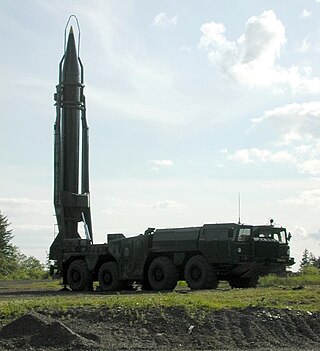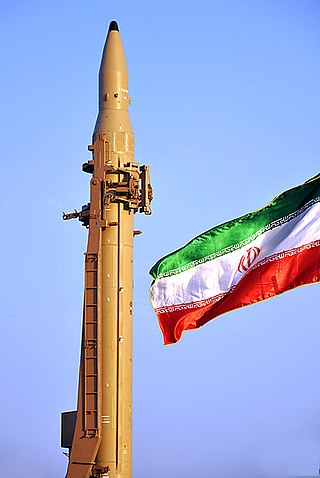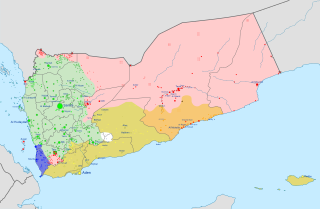Related Research Articles

USS Laboon (DDG-58) is an Arleigh Burke-class destroyer in the United States Navy. She is named for Father John Francis Laboon (1921–1988), a captain in the Chaplain Corps of the United States Navy, who was awarded the Silver Star during World War II while serving on the submarine USS Peto.

The VympelR-73 is a short-range air-to-air missile developed by Vympel NPO that entered service in 1984.

The Vympel R-27 is a family of air-to-air missile developed by the Soviet Union. It remains in service with the Russian Aerospace Forces, air forces of the Commonwealth of Independent States and air forces of many other countries as standard medium range air-to-air missile even though they have the more advanced R-77.

The HESA Ababil is an Iranian family of single-engine multirole tactical unmanned aerial vehicles manufactured by Iran Aircraft Manufacturing Industrial Company (HESA). The Ababil comes in four main lines, the Ababil-2 ,3, 4 and 5, of which the Ababil-2 has a number of variants. It is considered a long-range, low-technology drone.

The Houthi movement, officially known as Ansar Allah, is a Shia Islamist political and military organization that emerged from Yemen in the 1990s. It is predominantly made up of Zaidi Shias, with their namesake leadership being drawn largely from the Houthi tribe.

A Scud missile is one of a series of tactical ballistic missiles developed by the Soviet Union during the Cold War. It was exported widely to both Second and Third World countries. The term comes from the NATO reporting name attached to the missile by Western intelligence agencies. The Russian names for the missile are the R-11, and the R-17Elbrus. The name Scud has been widely used to refer to these missiles and the wide variety of derivative variants developed in other countries based on the Soviet design.

The Qiam 1 is a short-range ballistic missile designed and built by Iran. It was developed from the Iranian Shahab-2, a licensed copy of the North Korean Hwasong-6, all of which are versions of the Soviet Scud-C missile. The Qiam 1 entered service in 2010, with a range of 800 km (500 mi) and 100 m (330 ft) (CEP) accuracy.

The Chengdu GJ-1, also known as Wing Loong 1, is a Medium-Altitude Long-Endurance (MALE) unmanned aerial vehicle (UAV), developed by the Chengdu Aircraft Industry Group in the People's Republic of China. Intended for use as a surveillance and aerial reconnaissance platform, the Pterodactyl I is capable of being fitted with air-to-surface weapons for use in an unmanned combat aerial vehicle (UCAV) role.

CASC Rainbow is a series of unmanned aerial vehicles (UAVs) developed by the China Academy of Aerospace Aerodynamics, an entity under the China Aerospace Science and Technology Corporation (CASC). The China Academy of Aerospace Aerodynamics is also known as the 11th Academy of CASC or 701st Research Institute.
The Ya-Ali is an air-launched cruise missile (ALCM) built by Iran. The missile was first unveiled on 11 May 2014 when Iranian leader Grand Ayatollah Ali Khamenei visited the Aerospace Force of the Army of the Guardians of the Islamic Revolution. According to Janes Defence, the missile has a jet engine inlet and possibly uses a version of the Toloue-4 turbojet or different Toloue 10 or 13 engines Iran produces for its longer-range anti-ship missiles and it is reported to have a range of 700 km. On February 7, 2015, Iran's Deputy Defense Minister Mohammad Eslami announced that the missile could previously be launched from only Mirage type fighter planes but it can now be launched from every fighter plane that Iran owns. It is named after a Shi'i religious expression beseeching imam Ali. As an ALCM, the Ya-Ali is distinct from the ground launched cruise missiles (GLCMs) in the Houthi inventory. According to Jane's Defense Weekly, the Houthis may have used a Quds 1 GLCM in the Abha International Airport attack on 12 June 2019. This airport in southwestern Saudi Arabia is less than 200 km from the Yemeni border. The Iranian Ya-Ali has a much longer range due to being imparted with much more kinetic and potential energy when released from a fighter aircraft such as the Mirage type. The Houthis have no fighter aircraft in their inventory.

On 26 March 2015, Saudi Arabia, leading a coalition of nine countries from West Asia and North Africa, launched an intervention in Yemen following a new joint request from Yemeni president Abdrabbuh Mansur Hadi for military support after his forces were ousted from Sanaʽa by Houthi insurgents during the Yemeni Civil War. Government forces, Houthi rebels, and other armed groups fought after the draft constitution and power-sharing arrangements collapsed, despite progress made by the UN during the political transition at that time. Violence escalated in mid-2014. Houthis and allied insurgents seized control of Sana'a in September 2014 and thereafter. In response, President Hadi asked Saudi Arabia to intervene against the Iranian-backed Houthis.
The Burkan-2H, or Volcano-2H is a mobile short-range ballistic missile used by the Houthis militants in Yemen. The Volcano H-2 was first launched in July 2017. It is related to the Scud missile family.
The Burkan-1 or Volcano-1 is a mobile short-range ballistic missile used by the Houthis in Yemen. It is related to the Scud missile family.
The Abha International Airport attacks were cruise missile attacks carried out by the Yemeni Houthi rebels which occurred in June 2019. The attack targeted the arrivals hall of Abha International Airport in southwestern Saudi Arabia and killed one civilian and injured 47 others.

On 14 September 2019, drones were used to attack oil processing facilities at Abqaiq and Khurais (خريص) in eastern Saudi Arabia. The facilities were operated by Saudi Aramco, the country's state-owned oil company. The Houthi movement in Yemen claimed responsibility, tying it to events surrounding the Saudi intervention in the Yemeni Civil War and stating they used ten drones in the attack launched from Yemen, south of the facilities. Saudi Arabian officials said that many more drones and cruise missiles were used for the attack and originated from the north and east, and that they were of Iranian manufacture. The United States and Saudi Arabia have stated that Iran was behind the attack while France, Germany, and the United Kingdom jointly stated Iran bears responsibility for it. Iran has denied any involvement. The situation exacerbated the 2019 Persian Gulf crisis.

The Samad is a family of long-range UAVs of unidentified origin used in the Middle East. The Samad is available in three variants: The Samad-1, the Samad-2, and the Samad-3. The Samad family of UAVs is primarily used by the Houthi movement in the Yemeni civil war, where the drone's long range is used to strike targets in Saudi Arabia, Israel and the UAE.
The 2020 Riyadh drone and missile attack was a cruise missile and drone attack carried out by the Yemeni Houthi rebels which occurred on 23 June 2020. The attack, according to the Houthis, targeted the King Khalid Airport and the Defense Ministry headquarters in Saudi Arabia's capital of Riyadh.
On 30 December 2020, a plane carrying members of the recently formed Yemeni government landed at Aden International Airport in the southwest of Yemen. As passengers disembarked, there were explosions and gunfire, leaving 28 people dead and 107 others injured. None of the passengers were hurt in the attack and the Yemeni cabinet members were quickly transported to Mashiq Palace for safety.
The Shahed 131, or Geran-1 in Russian service, is an Iranian-made drone which came to prominence in October 2022 during the Russian invasion of Ukraine. It is powered by a Wankel engine model Shahed-783/788.
References
- ↑ "الحوثيون يعلنون تصنيع صواريخ وطائرات مسيرة لمواجهة التحالف". www.aa.com.tr.
- 1 2 Wright, Timothy, Barrie, Douglas (December 5, 2020), "Cruise missiles continue to make their mark in the Middle East", International Institute for Strategic Studies, retrieved 20 January 2024
- ↑ Williams, Ian; Shaikh, Shaan. "The Missile War in Yemen" (PDF).
- ↑ Hinz, Fabian (15 September 2019). "Meet the Quds 1". Arms Control Wonk. Retrieved 20 September 2019.
- ↑ Kirkpatrick, David D.; Koettl, Christoph; McCann, Allison; Schmitt, Eric; Singhvi, Anjali; Wezerek, Gus (September 16, 2019). "Who Was Behind the Saudi Oil Attack? What the Evidence Shows". The New York Times.
- 1 2 Binnie, Jeremy (8 July 2019). "Yemeni rebels unveil cruise missile, long-range UAVs". Jane's Defence Weekly. IHS. Retrieved 17 September 2019.
- ↑ "Letter dated 27 January 2020 from the Panel of Experts on Yemen addressed to the President of the Security Council" (PDF).
- ↑ Axe, David (September 17, 2019). "Houthis Have an Arsenal of Ballistic and Cruise Missiles (Some from North Korea)". The National Interest.
- ↑ Seidler, Christoph (16 September 2019). "Attacks on Saudi oil facilities: the riddling of weapons experts". Spiegel Online / The Limited Times. Retrieved 20 September 2019.
- ↑ "s/2020/70 - E - s/2020/70". undocs.org. Retrieved 2020-03-24.
- ↑ "صواريخ وطائرات بدون طيار: نظرة قريبة على أسلحة الحوثيين الجديدة (صور وفيديو)". July 8, 2019.
- ↑ Eshel, T. (2022), "Houthis a New Cruise Missile, Quds-3", Defense Update, retrieved 20 January 2024